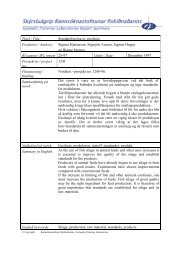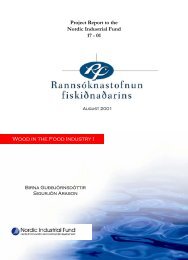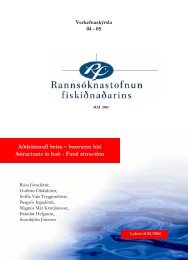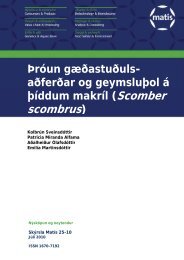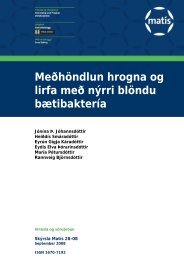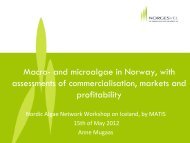Microbiology and Spoilage Trail in Nile Perch (Lates niloticus), Lake ...
Microbiology and Spoilage Trail in Nile Perch (Lates niloticus), Lake ...
Microbiology and Spoilage Trail in Nile Perch (Lates niloticus), Lake ...
Create successful ePaper yourself
Turn your PDF publications into a flip-book with our unique Google optimized e-Paper software.
which are pos<strong>in</strong>g difficulties <strong>in</strong> develop<strong>in</strong>g physical measurements. Jason <strong>and</strong> Richards,<br />
(1975) came up with <strong>in</strong>strument, GR Torrymeter which can only grade batches of fish <strong>and</strong> is<br />
not able to measure quality or freshness of a s<strong>in</strong>gle fish. The pH is the only measurement<br />
which has been commonly used as physical method for quality assessment by us<strong>in</strong>g pH-meter<br />
directly <strong>in</strong>to the fish muscle or <strong>in</strong> suspension of fish flesh/muscles <strong>in</strong> distilled water.<br />
2.6.3 Microbiological methods<br />
The microbiological analysis is the second most used traditional method which determ<strong>in</strong>es<br />
the quantity of microbial cells <strong>in</strong> particular foods referred to as total counts. Traditional<br />
methods for bacteriological exam<strong>in</strong>ations can be laborious, time-consum<strong>in</strong>g, <strong>and</strong> costly<br />
compared to sensory <strong>and</strong> chemical methods which only take few hours, (Huss, 1995).<br />
Common traditional plate count agars (PCA) are still the substrates widely used for<br />
determ<strong>in</strong>ation of total counts. Total count represents the total number of bacteria that are<br />
capable of form<strong>in</strong>g visible colonies on a culture media at a given temperature. An example<br />
of different methods used for determ<strong>in</strong>ation of bacterial counts <strong>in</strong> fish <strong>and</strong> fish products are<br />
given <strong>in</strong> table 8 below.<br />
Table 8: Methods for determ<strong>in</strong>ation of the content of bacteria <strong>in</strong> seafood (Huss, 1995)<br />
Method Temperature, °C Incubation cfu/g Sensitivity<br />
Plate count or Iron agar 15-25 3-5 days 10<br />
"Redigel"/"Petrifilm(tm) SM" 15-25 3-5 days 10<br />
Microcolony-DEFT 15-30 3-4 hours 10 4 -10 5<br />
DEFT -- 30 m<strong>in</strong>. 10 4 -10 5<br />
ATP -- 1 hour 10 4 -10 5<br />
Limulus lysate test -- 2-3 hours 10 3 -10 4<br />
Microcalorimetry/<br />
Dye reduction/<br />
Conductance/Capacitance<br />
24<br />
15-25 4-40 hours 10<br />
When exam<strong>in</strong><strong>in</strong>g bacteria <strong>in</strong> seafoods, more nutrient rich agar (Iron Agar, Lyngby, <strong>and</strong><br />
Oxoid) gives significantly higher counts than PCA (Gram, 1990). Iron agar yields both the<br />
number of specific spoilage (hydrogen sulphide produc<strong>in</strong>g) <strong>and</strong> non spoilage bacteria. The<br />
<strong>in</strong>cubation temperature dictates <strong>in</strong> the total counts. Incubation at ≥30°C seems to be<br />
<strong>in</strong>appropriate when exam<strong>in</strong><strong>in</strong>g seafood products be<strong>in</strong>g held at chill temperatures. Pour




